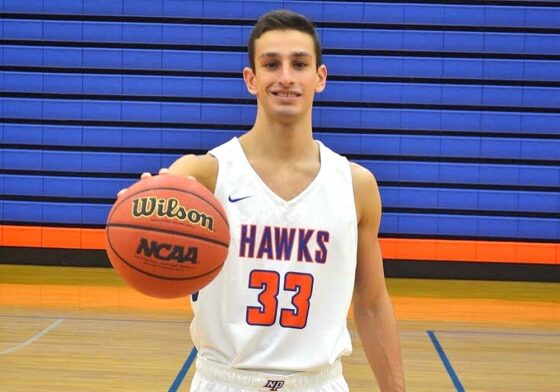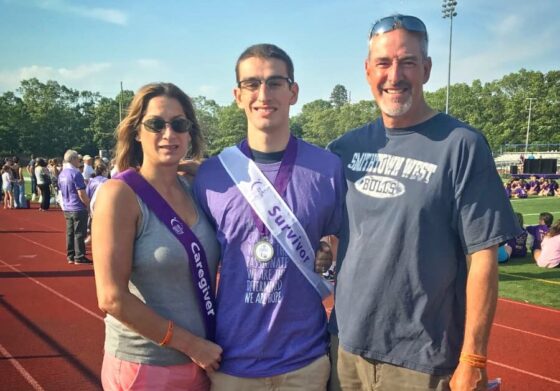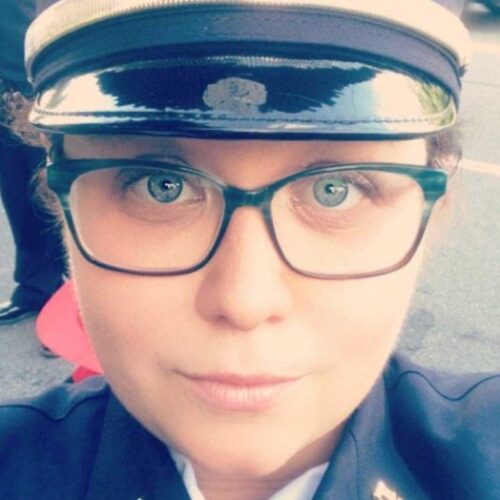Prior to my diagnosis, I was always a very healthy, active, and athletic teenager, so my health was never an area of concern.
In high school, I was an all-county athlete and received MVP awards in basketball and track and field. I decided to continue my athletic career by playing basketball in college, where I was constantly working out, whether lifting weights or conditioning. I would rarely get sick besides a common cold, which would normally clear up in a day or two.
The first major health change that I noticed was extreme bruising from an injury that I sustained during one of my basketball games sophomore season. While playing defense, I was hit in the hip by an opposing player’s knee, which eventually sidelined me for the rest of the game.
My hip proceeded to swell up and bruise abnormally in the following days, and the pain was so unbearable that I was unable to walk correctly for about a week. Once the swelling started to go down, the underside of my entire right leg began to bruise dark purple.
While the athletic trainers dismissed this as nothing to be concerned about, I had a feeling something was not right because of my prior experiences with athletic injuries and bruising healing much quicker. It then took a few weeks until all the bruising finally healed.
After the injury to my hip, my family and I became a little more in tune with my body as the season progressed. My parents both agreed that I didn’t look like my normal self after games, and at times I looked ghostly pale and dehydrated.
I felt like I was lacking my usual strength and energy during practices and games, but I honestly didn’t think too much of this, because I have pushed through adversity my whole life. Not once did it ever cross my mind that this could potentially be something as serious as cancer.
I believed my body was just fatigued from the long duration of the season, and that I would eventually be able to get my rest once all the games were over. However, the fatigue only worsened once the season was completed, and I noticed that I was sleeping much more than usual and was constantly taking naps.
Then, the biggest red flag that I received right before my diagnosis occurred during Easter break. I was helping my dad with some yard work when I accidentally glanced up at the sun for a brief moment. Usually, I would blink and wait a few moments until the sun blotch in my eye went away, but it never did.
“Often times, changes in your body can be gradual, which makes it more difficult to notice an immediate difference from your normal health.”
For the next week, I had a large blind spot in the center of my left eye’s vision. This eventually led me to see an eye doctor once I returned to school. After examining my eye and being unable to figure out exactly what was wrong with me, the initial eye doctor then referred me to a retina specialist, who insisted I get my blood tested immediately after noticing Roth’s spots (blood hemorrhages) in both of my eyes.
After a few days of testing, the hematologist called up and said what he was seeing in my blood were signs of chronic myeloid leukemia, which is a very rare form of leukemia. White blood cell count for a healthy person typically lies in the 5,000 – 10,000 range; mine was at 400,000 when I was initially diagnosed.
From there, I was quickly admitted to the hospital, where I underwent a week of chemotherapy and other processes to bring my blood count down significantly.
If I can offer any advice to those who have read my story, it would be to stay in tune with your body. Often times, changes in your body can be gradual, which makes it more difficult to notice an immediate difference from your normal health.
Fortunately, in my situation, my eye issue required immediate attention and forced me to see a doctor, but in retrospect I should have gotten my blood tested after the extreme bruising I had during my basketball season. Additionally, I could’ve also seen a doctor about my persistent fatigue and I might’ve been diagnosed much earlier, which would have made the recovery process much easier.
Therefore, it is very important to act on anything that may seem out of the norm. The body will let you know when something is not right, but it is on us to listen and be honest with ourselves.
Symptoms
- extreme bruising
- change in complexion
- fatigue
- blind spot in center of the eye that lasted for days









